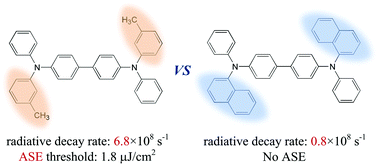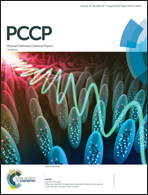Theoretical evidence of low-threshold amplified spontaneous emission in organic emitters: transition density and intramolecular vibrational mode analysis
Abstract
Organic gain materials are highly attractive for lasing due to their chemical tunability and large stimulated emission cross sections. In previous reports, the radiative decay rate kr was considered as an important factor to determine outstanding amplified spontaneous emission (ASE) performance of organic molecules. In this study, we use quantum mechanics to reveal the influential factors on photophysical properties of organic emitters, and give insight into the effect of kr on ASE performance. Based on the theoretical analysis of three molecules with similar structure, calculated results show that large kr derives from enhanced transition density ρ between the electronic wave functions of the ground-state and the lowest excited singlet state as well as a handful of low-frequency torsional modes with small Huang–Rhys factor S, further, kr values are calculated depending on molecular vibration terms. In addition, through the analysis of non-radiative decay rate knr considering vibration terms (vibronic coupling constants), the comparison of kr and knr shows that the radiative decay process is promoted in the three molecules. The two aspects are desired for outstanding ASE performance. Our work shows that the roles of transition density and vibrational modes are crucial to clarify the photophysical properties, which govern the ASE performance in organic light emitters.



 Please wait while we load your content...
Please wait while we load your content...